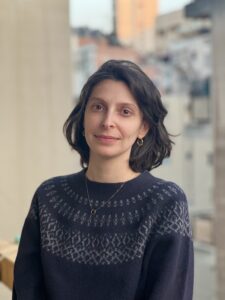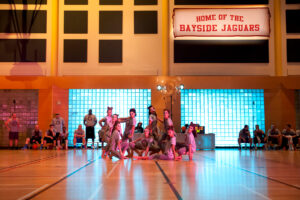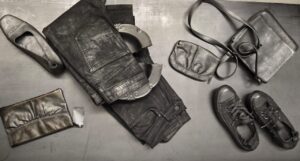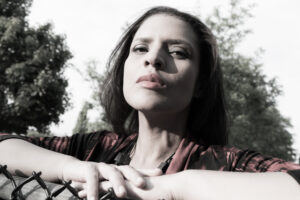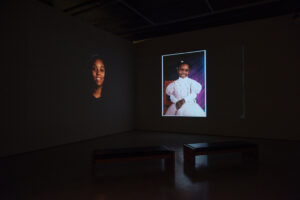Tina Rouhandeh is a visual artist working across calligraphy and fiber art. Born in Tehran, Iran, in 1977, Rouhandeh showed an early interest in art and began creating works at a young age. After studying Persian calligraphy and illumination at the Iranian Calligraphy Association in Tehran, she embarked on a career in the arts. Her work bridges classical techniques with contemporary art. She draws inspiration from Persian calligraphy and seeks to express her own personal and cultural experiences. Her work has been exhibited in numerous group and solo shows, and several of her pieces are part of the Royal Ontario Museum’s textile collection. She continues to create new works and push the boundaries of her medium, striving to challenge herself and engage viewers in a meaningful way. Rouhandeh currently lives and works in Windsor, where she maintains a studio and teaches calligraphy and hand stitching.
- Home
- Exhibitions + Displays
- Tina Rouhandeh: Inquiry about Forgotten Birds
Tina Rouhandeh: Inquiry about Forgotten Birds
June 13, 2023 - October 1, 2023
Second Floor

How can we excavate and preserve the untold narratives of a people when those very narratives are at risk of erasure? In what ways do traditional crafts embody the immaterial layers of history? What is at stake when we attempt to leave a physical trace of that which is intangible? Working across calligraphy, hand-stitching, and weaving, Tina Rouhandeh’s practice reflects on loss and absence, and the ways in which they can (or cannot) be articulated and materialized.
Rouhandeh was born and raised in Iran, and at the age of 18, trained in Persian calligraphy in Tehran—one of the few artforms that she could study as a member of Bahá’í faith in the country. Dating as far back as the 7th century, calligraphy gradually transformed from a documentation tool into an artform in its own right. Calligraphers created styles and patterns of writing that extended beyond the page itself and onto architecture, pottery, and metal work. Crucially, scribes were tasked with using their craft to keep a record of their time, copying history books and governmental records as well as manuscripts.
In order to rule the pages of their manuscripts, scribes are known to use a mastar—a set of cotton strings stretched over a frame, which produces a written area with a specific set of lines on the page. Drawing on the functionality of mastar in calligraphy, and on the role of scribe-calligraphers as keepers of history, Rouhandeh creates pieces that weave together both words and threads, producing hybrid works that unearth stories of persecution in Iran. Mounted on black canvas, each one of these works amplifies the stories of those whose voices have been forcibly silenced and erased, be it prisoners, people of the Bahá’í faith, Iranian youth, and women, whose most basic rights have been violated for decades. Rouhandeh has been working on the series Inquiry about Forgotten Birds for the past five years; her work is a testament to the continued urgency of speaking up against human rights violations in Iran.
Tina Rouhandeh’s work is a labor of time. Each of the works presented here is made up of nearly 3,500 bullion stitches. A single one of these hand stitches—created by twisting a thread around a needle several times, and then inserting it into the fabric—takes about twenty minutes to complete. Weaving, stitching, and calligraphing for more than twelve hours a day—often working for up to fifteen hours—it can take Tina seven months to complete one work. Arduous and demanding, this durational process requires remarkable endurance and patience, preserving not only the art of calligraphy, but the countless stories of those being persecuted in Iran today.
This exhibition forms part of Below the 6, a series of exhibitions that focuses on artists based in Southwestern Ontario whose practices are socially and politically minded.
Below the 6 is curated by TD Curatorial Fellow Muriel N. Kahwagi and is generously supported by TD Bank Group.

About the Artist: Tina Rouhandeh

About the Curator: Muriel N. Kahwagi
Muriel N. Kahwagi is a writer and cultural worker, working primarily across publishing and programming. Her research is centered on the politics of archiving oral poetry and histories; and the act of listening as a form of preservation in and of itself. She has held editorial roles at both the Sursock Museum (2015-2021) and the Arab Image Foundation (2021-2022) in Beirut, and since 2022 has been a programmer at the Toronto Arab Film Festival. Her first edited volume, Al Qasid: The real and imagined histories of sung poetry, brings together contributions from scholars, artists, and composers, exploring the politics of archiving sung poetry, and the mediation and transmission of memories and folkloric traditions. This publication, released in November 2022, was supported by the Arab Fund for Arts and Culture (AFAC) and Hammana Artist House.
